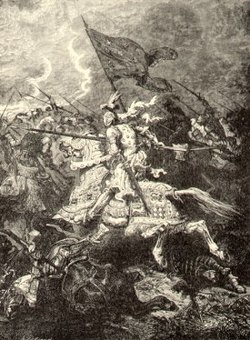Battle of Crécy

| |||||||||||||||||
| Battle of Crécy | |||||||||||||||||
|---|---|---|---|---|---|---|---|---|---|---|---|---|---|---|---|---|---|
| Conflict | Hundred Years' War | ||||||||||||||||
| Date | August 26, 1346 | ||||||||||||||||
| Place | South of Calais, near Crécy-en-Ponthieu | ||||||||||||||||
| Result | Decisive English victory | ||||||||||||||||
| |||||||||||||||||
The Battle of Crécy took place on August 26 1346, near Crécy-en-Ponthieu, in the Somme département of northern France and was one of the defining combats of arms of the Hundred Years' War.
Crécy was a battle in which an English army of approximately 12,000, commanded by Edward III of England, outnumbered by Philip VI of France's force of between 30,000 and 40,000, was victorious as a direct consequence of superior weaponry and tactics. The actual number for each army varies considerably according to the source used, but there is general agreement that the English troops numbered far fewer than the French.
The Battle of Sluys was the first great battle of the Hundred Years' War, on June 23, 1340. After this battle, Edward attempted to invade France through Flanders, yet failed. 6 years later, Edward attacked Normandy, and the number of easy victories that followed culminated in the Battle of Crécy.
The battle is seen by many historians as the beginning of the end of chivalry, because during the course of the battle many of the prisoners and wounded were dispatched contrary to chivalric codes of warfare, and the illustrious noble cavalry was no longer undefeatable by infantry. The site of the battle is preserved and nowadays can be overlooked from a special viewing tower.
The prelude to the battle of Crécy is the subject of a poem by the 19th century English poet William Morris, The Eve of Crécy.
English dispositions
As in the previous battles against the Scottish, Edward III chose to place his forces in an area of flat agricultural terrain, surrounded by natural obstacles in the flanks. The king placed himself and his staff in a windmill at the small hill that protected the rear, where he could control the course of the battle. In a strongly defensive position, Edward III ordered that everybody should fight on foot and distributed the army between three groups. His sixteen-year-old son, Edward, the Black Prince, was to command one of them. The army's secret weapon, the longbowmen recruited from his Welsh dominions, were arrayed in a V-formation along the crest of the hill. In the period of waiting time that followed, the English built a system of ditches, pits and caltrops to maim and bring down the enemy cavalry.
The battle
The French army, commanded by Philip VI, was much more disorganized, due to an excess of confidence on the part of his noble knights. Roughly, Philip stationed his Genoese mercenary crossbowmen in the front line, with the cavalry in the back.
The first attack was from the crossbowmen, which charged a shower of volleys with the purpose of disorganize and frighten the English infantry. This first move was made with the sound of musical instruments, brought by Philip VI to scare the enemy. But the crossbowmen would prove completely useless. With a firing rate of 3 to 5 volleys a minute, they were no match to the longbowmen, who could fire 10 to 12 arrows in the same time. Furthermore, their weapons were damaged by the rainfall that occured before the battle while the longbowman were able to avoid harm to their weapons by simply unstringing their bows until the weather improved. Frightened and confused they retreated with heavy losses, some of them accidentally smashed by the French cavalry.
Seeing the feeble result of the crossbowmen, the French cavalry charged, organized in rows. However the slope and manmade obstacles, disrupted the might of the charge. At the same time, the longbowmen discharged a curtain of arrows on the knights. The attack could not break the English formation, even after several attempts.
At nightfall, Philip VI, himself wounded, ordered retreat. The result was a humiliating defeat for France.
Casualties
The losses were enormous and among the dead were important nobles such as:
- Charles of Valois, count of Alençon, Philip VI's brother (b.1297)
- John I, Count of Luxemburg and King of Bohemia (b.1296)
- Louis I, Count of Flanders (b.1304)
- Rudolph, Duke of Lorraine (b.1320)
Aftermath
This battle established the military supremacy of the English longbow over the French combination of crossbow and armoured knights (due to significantly greater rate of fire and a longer range in the hands of a skilled user), and was to significantly alter the way in which war was conducted for a considerable period of time thereafter. After the Battle of Crécy, Edward III proceeded to besiege the city of Calais, which surrendered to him shortly afterwards, establishing the English dominion on northern France. The following battle in the Hundred Years War, Poitiers in 1356, would return an equal utter defeat for the French.
External links
References
- Crecy, 1346: Anatomy of a Battle by Henri de Wailly ISBN 0713719303
- "The Western Heritage, Seventh Edition; From 1300" by Donald Kagan, Steven Ozment, and Frank M. Turner ISBN 0-13-027719-3 (textbook)